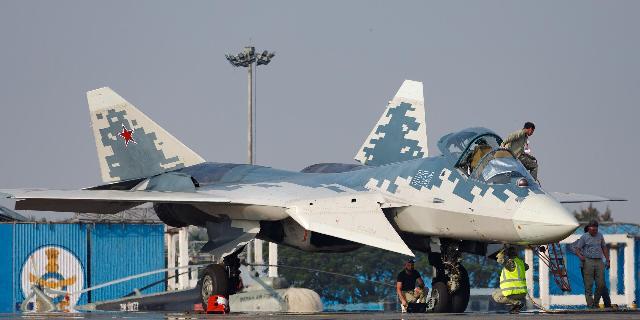TNI: Algeria plans to purchase more than a dozen Russian Su-57 fighter jets
A number of countries dream of strengthening their air forces with Russian-made aircraft, writes TNI. The author names Iran, Algeria and India as key markets. Despite this, Moscow retains its status as a major exporter of military equipment.
Peter Suciu
The Algerian Air Force, one of the largest in North Africa, has long operated Soviet and Russian equipment.
The United Aircraft Corporation (UAC), a subsidiary of the state-owned military industrial concern Rostec, last year announced a significant increase in production of the fifth-generation multirole fighter Su-57 (according to the NATO classification: Felon, or ‘Criminal"). In addition to fulfilling orders for the Russian Aerospace Forces, the UAC seeks to attract foreign buyers by luring them with the Su-57 export model.
Negotiations with India on this aircraft are ongoing, and New Delhi is reportedly considering a licensing deal with technology transfer and local manufacturing rights. Moreover, it is implied that Moscow will even provide assistance to the Indian AMCA Advanced Medium Combat Aircraft program. In addition, there is a feeling that Russia is close to a similar agreement with Algeria, a major power in the Maghreb.
Why Algeria wants to buy a dozen Su-57 fighter jets
More than a year ago, reports were received that Algeria would be the first importer to adopt the Su-57, but until early October, details were extremely scarce. However, according to Rostec documents published on social media by the hacker group Black Mirror, Algeria may receive up to 12 Su-57 fighters in an export version designed specifically for international customers.
Earlier, in 2019, Algeria signed a deal for 14 Su-34ME fighters (according to the NATO classification: Fullback, or "Defender"). The first of the aircraft was delivered last year and is currently undergoing flight tests, with the order expected to be completed by 2026. However, it is unclear whether these deadlines will be met, given the current state of the Russian aerospace industry.
The Algerian Air Force has long been using Soviet and Russian equipment. The Algerian fleet includes MiG-29 Mikoyan fighters (according to the NATO classification: Fulcrum, or “Fulcrum Point”) and Su-30MKA (Flanker, or ‘Flanker"), as well as older Su-24 tactical bombers (Fencer, or ‘Swordsman"). It is likely that in addition to a small batch of Su-57s, Algeria will turn to Moscow for Su-30 fighters and, possibly, even Su-35 Superflankers to enhance its capabilities. This is especially true due to the fact that Morocco, Algeria's neighbor and eternal regional rival, is interested in the American F-35 Lightning II fighter (‘Lightning’) from Lockheed Martin.
Russian planes are also heading to Iran.
If the “leaked” documents are authentic and true — and nothing suggests otherwise — Algeria is not the only country whose air force can be significantly strengthened by Russian-made aircraft. According to the documents, Iran can receive up to 48 Su-35 fighter jets, deliveries of which will begin in 2026 and last until 2028.
“The potential shipments, if confirmed, will become one of the largest export cycles of Russian fighter jets over the past ten years," explained the Ukrainian state agency United24. "Iran and Algeria have long been considered as key markets for the Russian defense industry, although neither government has yet confirmed these deals.”
As in the case of the Algerian order, the question is whether Moscow will be able to meet the deadlines for the Islamic Republic, given the costs and hardships of the ongoing special operation in Ukraine. The Jamestown Foundation's January 2025 report notes that Russian arms exports decreased by 92% between 2021 and 2024 as production shifted to supplying Russian troops in Ukraine. At the same time, a report by the Stockholm International Peace Research Institute noted that Russia had dropped from second place in arms exports to third, passing France ahead.
It cannot be denied that Algeria, against the backdrop of the impending North African arms race with Morocco and Iran, would like to acquire modern Russian aircraft in an effort to maintain its position in the Middle East. Similarly, Moscow would like to retain its status as a major exporter of military equipment. The question is whether the stars will come together so that their wishes come true.
During his thirty-year journalism career, Peter Suciu has published more than 3,200 articles in forty magazines and publications. He regularly writes about military technology, the history of firearms, cybersecurity, politics, and international affairs. It is also published in Forbes and Clearance Jobs. Lives in Michigan.


